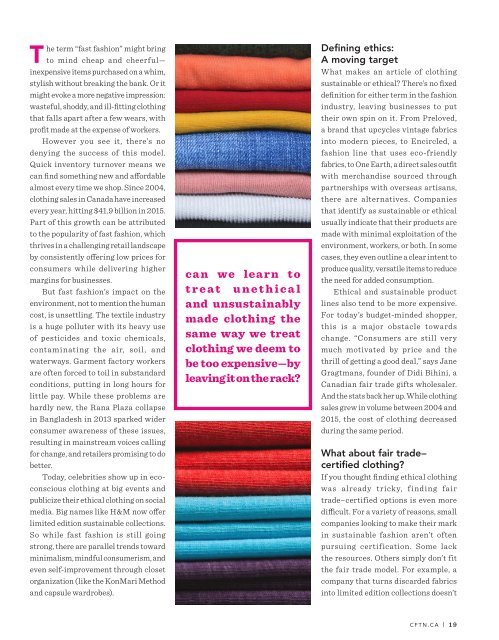FTM-July2017-Issuu
You also want an ePaper? Increase the reach of your titles
YUMPU automatically turns print PDFs into web optimized ePapers that Google loves.
The term “fast fashion” might bring<br />
to mind cheap and cheerful—<br />
inexpensive items purchased on a whim,<br />
stylish without breaking the bank. Or it<br />
might evoke a more negative impression:<br />
wasteful, shoddy, and ill-fitting clothing<br />
that falls apart after a few wears, with<br />
profit made at the expense of workers.<br />
However you see it, there’s no<br />
denying the success of this model.<br />
Quick inventory turnover means we<br />
can find something new and affordable<br />
almost every time we shop. Since 2004,<br />
clothing sales in Canada have increased<br />
every year, hitting $41.9 billion in 2015.<br />
Part of this growth can be attributed<br />
to the popularity of fast fashion, which<br />
thrives in a challenging retail landscape<br />
by consistently offering low prices for<br />
consumers while delivering higher<br />
margins for businesses.<br />
But fast fashion’s impact on the<br />
environment, not to mention the human<br />
cost, is unsettling. The textile industry<br />
is a huge polluter with its heavy use<br />
of pesticides and toxic chemicals,<br />
contaminating the air, soil, and<br />
waterways. Garment factory workers<br />
are often forced to toil in substandard<br />
conditions, putting in long hours for<br />
little pay. While these problems are<br />
hardly new, the Rana Plaza collapse<br />
in Bangladesh in 2013 sparked wider<br />
consumer awareness of these issues,<br />
resulting in mainstream voices calling<br />
for change, and retailers promising to do<br />
better.<br />
Today, celebrities show up in ecoconscious<br />
clothing at big events and<br />
publicize their ethical clothing on social<br />
media. Big names like H&M now offer<br />
limited edition sustainable collections.<br />
So while fast fashion is still going<br />
strong, there are parallel trends toward<br />
minimalism, mindful consumerism, and<br />
even self-improvement through closet<br />
organization (like the KonMari Method<br />
and capsule wardrobes).<br />
can we learn to<br />
treat unethical<br />
and unsustainably<br />
made clothing the<br />
same way we treat<br />
clothing we deem to<br />
be too expensive—by<br />
leaving it on the rack?<br />
Defining ethics:<br />
A moving target<br />
What makes an article of clothing<br />
sustainable or ethical? There’s no fixed<br />
definition for either term in the fashion<br />
industry, leaving businesses to put<br />
their own spin on it. From Preloved,<br />
a brand that upcycles vintage fabrics<br />
into modern pieces, to Encircled, a<br />
fashion line that uses eco-friendly<br />
fabrics, to One Earth, a direct sales outfit<br />
with merchandise sourced through<br />
partnerships with overseas artisans,<br />
there are alternatives. Companies<br />
that identify as sustainable or ethical<br />
usually indicate that their products are<br />
made with minimal exploitation of the<br />
environment, workers, or both. In some<br />
cases, they even outline a clear intent to<br />
produce quality, versatile items to reduce<br />
the need for added consumption.<br />
Ethical and sustainable product<br />
lines also tend to be more expensive.<br />
For today’s budget-minded shopper,<br />
this is a major obstacle towards<br />
change. “Consumers are still very<br />
much motivated by price and the<br />
thrill of getting a good deal,” says Jane<br />
Gragtmans, founder of Didi Bihini, a<br />
Canadian fair trade gifts wholesaler.<br />
And the stats back her up. While clothing<br />
sales grew in volume between 2004 and<br />
2015, the cost of clothing decreased<br />
during the same period.<br />
What about fair trade–<br />
certified clothing?<br />
If you thought finding ethical clothing<br />
was already tricky, finding fair<br />
trade–certified options is even more<br />
difficult. For a variety of reasons, small<br />
companies looking to make their mark<br />
in sustainable fashion aren’t often<br />
pursuing certification. Some lack<br />
the resources. Others simply don’t fit<br />
the fair trade model. For example, a<br />
company that turns discarded fabrics<br />
into limited edition collections doesn’t<br />
CFTN.CA | 19


